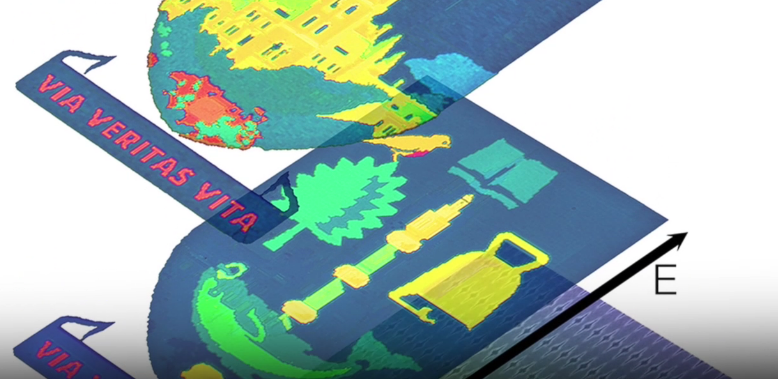The breakthrough, detailed in a paper published in the Journal of Advanced Functional Materials, represents an advance in the field of structural colour printing, whereby structured nanomaterials are used to render colours.

The Glasgow technique allows the ‘printing’ of two entirely different, but highly detailed, full-colour images within the same surface area, something which the group claims has never been done before using ‘structural colour’ techniques. This has been achieved by the development of special nano-scale plasmonic colour filters that display different colours depending on the orientation of the light which hits it.
The team’s breakthrough comes from including an additional nanoscale element in the structural colour process, created at the University’s James Watt Nanofabrication Centre.
Lead author of the paper Dr Alasdair Clark said: “We’ve discovered that if we make colour pixels from tiny cross-shaped indents on a strip of aluminium film, the colour they display becomes polarisation-dependent, allowing us to encode two colours into a single pixel, and then select which colour is displayed by shining different polarisations of light at the surface. By changing the size and shape of the nanoscale indent, we can create a wide range of different colours at very high resolutions.”
According to the team, the process enables the creation of far-higher resolution prints than is possible with conventional printing techniques. For instance, whilst a typical printed image in a magazine might consist of around 300 coloured dots per inch of page, a page ‘printed’ with structural colour techniques could reach a resolution of 100,000 DPI or more.
"We’ve worked out that we could store 1.46 Gb per square centimetre"
Clark said that the technology has a number of potential applications, including the development of new anti-counterfeiting materials for banknotes. "A very good example of where we see a technology like this being used is anti-counterfeiting whereby you can create incredibly high-resolution images of over 100,000 dpi, embed those on a surface like a bank note and you would have this incredibly difficult to forge hi-res image that when you shine different polarisation of life at the surface you would get different images back," he said.
What’s more, because the colours don’t fade even when exposed to the harshest sunlight the process also holds great promise for long-term data archival. “We’ve worked out that we could store 1.46 Gb per square centimetre, so a single A4 sheet could hold more than 900 Gb of data,” added Clark.





Swiss geoengineering start-up targets methane removal
No mention whatsoever about the effect of increased methane levels/iron chloride in the ocean on the pH and chemical properties of the ocean - are we...